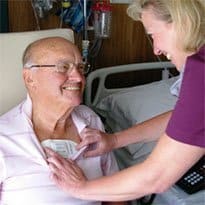Spire hospital trials wearable monitors
- 7 August 2014

Montefiore Hospital in Brighton has become one of the first to deploy wearable vital signs monitors for patients.
The private hospital, owned by Spire Healthcare, is using the SensiumVitals system.
This is a disposable wireless patch that is attached to a patient’s chest with sensors that measure heart rate, temperature and respiration rate every two minutes.
The data is automatically sent to nurse stations and handheld devices. If the readings are abnormal, an alert is sent to staff, who can treact if a patient’s condition is deteriorating.
Lynette Awdry, a matron at the hospital, said in a statement that although nothing “can replace the ‘eyes on’ assessment” that nurses carry out, the system provides an “extra layer” of monitoring.
“The key advantage of the system is the frequency of the data sent automatically from the patch – it keeps nurses up to date with all their patients, so they can manage their workload more effectively,” she said.
“As a result, they can spend time with patients who might need more immediate attention, safe in the knowledge that if there is a sudden change with another patient, they can respond immediately.”
Each patch lasts for five days and weighs 15g. The patches have been worn by more than 50 patients since the first received one of the devices in May.
The system has been created by Oxford-based company Sensium Healthcare, which is owned by the Toumaz Group. The company is talking to several NHS hospitals interested in deploying the system over the next 12 months.
It has also been awarded £250,000 by the Technology Strategy Board to support a joint project with the University of Leicester’s diagnostics development unit to build the next generation of wireless monitoring systems.
Anthony Sethill, the chief executive of the Toumaz Goup, said that over the coming months, he expects the system to be introduced to a “significant number of hospitals”, both private and NHS.
“By taking vital signs measurements every two minutes, the system allows clinicians to react swiftly to signs of patient deterioration,” he added.
“This provides reassurance to both patients and staff and offers the firm prospect of improving patient outcomes and reducing the length of hospital stays.”
Sethill said the funding from the Technology Strategy Board is recognition of the company’s potential, and will allow it to expand the system’s capabilities with the university and ensure it is designed to fit the needs of clinicians and patients.
The Technology Strategy Board was set up by the government to promote innovation in the UK, and to support small and medium sized enterprises.
It is chaired by Phil Smith, the head of Cisco in the UK, who discusses its work and the future of healthcare IT in an EHI interview with EHI editor Jon Hoeksma.





